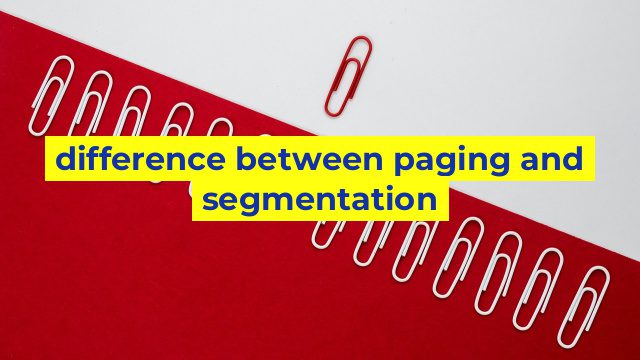The Difference between Paging and Segmentation: Understanding Memory Management
When it comes to managing memory in an operating system, two common techniques used are paging and segmentation. Although they are both used to divide physical memory into smaller parts for efficient management, they differ in their approach and implementation.
Paging
Paging is a method of memory management where physical memory is divided into fixed-size blocks called pages. Each page is of the same size and is managed separately. When a process requires memory, the operating system allocates the required amount of space in page frames. The process is then divided into pages that fit within the page frames. This approach allows for easy and efficient allocation and deallocation of memory space.
Paging provides a logical memory space that is divided into equally sized pages. The pages are mapped onto physical memory by a paging mechanism which maintains a page table in memory. The page table keeps track of which pages of a process are stored in which physical pages. When a process accesses memory, the operating system translates the virtual page number to a physical page number using the page table.
Segmentation
Segmentation is another method of memory management where a process is divided into logical segments of varying sizes. Segments can be of different sizes and represent different parts of a process such as code, data, and stack. Each segment is managed separately and can grow or shrink depending on the needs of the process.
Unlike paging, segmentation allows a process to have a non-contiguous logical address space. The operating system maintains a segment table that maps the logical segments to physical memory addresses. When a process accesses memory, the operating system translates the logical address to a physical memory address using the segment table.
Key Differences
The main difference between paging and segmentation lies in their approach and implementation. Paging divides physical memory into fixed-sized blocks, while segmentation divides a process into logical segments of varying sizes.
Another important difference is that paging provides a contiguous logical memory space, while segmentation allows a process to have a non-contiguous logical address space.
Lastly, paging is used in systems where the process size is smaller, while segmentation is used in systems where processes are larger and require non-contiguous logical memory.
In conclusion, both paging and segmentation are important techniques used in managing memory in operating systems. Understanding the differences between these two techniques can help system designers choose the best approach for managing memory in their systems.
Table difference between paging and segmentation
| Paging | Segmentation |
|---|---|
| It’s a memory management technique used in operating systems where memories are divided into fixed-sized pages. | It’s also a memory management technique used in operating systems where memories are divided into variable-sized segments. |
| Paging has a fixed size for each page, usually smaller than the memory segment. | Segmentation provides flexibility in size as segments can be of different sizes. |
| It’s easier to implement and manage, but may lead to internal fragmentation. | It’s more complex to implement and manage, but can reduce internal fragmentation. |
| Paging is more suitable for systems that require large virtual memory but have limited physical memory. | Segmentation is more suitable for systems where memory of different sizes is required for different processes. |

